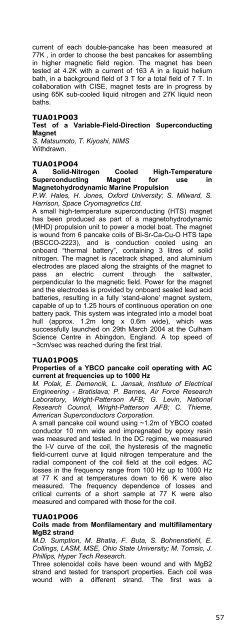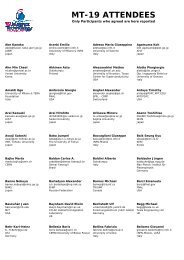Click here to download the abstract booklet in pdf format - MT19 - Infn
Click here to download the abstract booklet in pdf format - MT19 - Infn
Click here to download the abstract booklet in pdf format - MT19 - Infn
Create successful ePaper yourself
Turn your PDF publications into a flip-book with our unique Google optimized e-Paper software.
current of each double-pancake has been measured at<br />
77K , <strong>in</strong> order <strong>to</strong> choose <strong>the</strong> best pancakes for assembl<strong>in</strong>g<br />
<strong>in</strong> higher magnetic field region. The magnet has been<br />
tested at 4.2K with a current of 163 A <strong>in</strong> a liquid helium<br />
bath, <strong>in</strong> a background field of 3 T for a <strong>to</strong>tal field of 7 T. In<br />
collaboration with CISE, magnet tests are <strong>in</strong> progress by<br />
us<strong>in</strong>g 65K sub-cooled liquid nitrogen and 27K liquid neon<br />
baths.<br />
TUA01PO03<br />
Test of a Variable-Field-Direction Superconduct<strong>in</strong>g<br />
Magnet<br />
S. Matsumo<strong>to</strong>, T. Kiyoshi, NIMS<br />
Withdrawn.<br />
TUA01PO04<br />
A Solid-Nitrogen Cooled High-Temperature<br />
Superconduct<strong>in</strong>g Magnet for use <strong>in</strong><br />
Magne<strong>to</strong>hydrodynamic Mar<strong>in</strong>e Propulsion<br />
P.W. Hales, H. Jones, Oxford University; S. Milward, S.<br />
Harrison, Space Cryomagnetics Ltd.<br />
A small high-temperature superconduct<strong>in</strong>g (HTS) magnet<br />
has been produced as part of a magne<strong>to</strong>hydrodynamic<br />
(MHD) propulsion unit <strong>to</strong> power a model boat. The magnet<br />
is wound from 6 pancake coils of Bi-Sr-Ca-Cu-O HTS tape<br />
(BSCCO-2223), and is conduction cooled us<strong>in</strong>g an<br />
onboard “<strong>the</strong>rmal battery”, conta<strong>in</strong><strong>in</strong>g 3 litres of solid<br />
nitrogen. The magnet is racetrack shaped, and alum<strong>in</strong>ium<br />
electrodes are placed along <strong>the</strong> straights of <strong>the</strong> magnet <strong>to</strong><br />
pass an electric current through <strong>the</strong> saltwater,<br />
perpendicular <strong>to</strong> <strong>the</strong> magnetic field. Power for <strong>the</strong> magnet<br />
and <strong>the</strong> electrodes is provided by onboard sealed lead acid<br />
batteries, result<strong>in</strong>g <strong>in</strong> a fully ‘stand-alone’ magnet system,<br />
capable of up <strong>to</strong> 1.25 hours of cont<strong>in</strong>uous operation on one<br />
battery pack. This system was <strong>in</strong>tegrated <strong>in</strong><strong>to</strong> a model boat<br />
hull (approx. 1.2m long x 0.6m wide), which was<br />
successfully launched on 29th March 2004 at <strong>the</strong> Culham<br />
Science Centre <strong>in</strong> Ab<strong>in</strong>gdon, England. A <strong>to</strong>p speed of<br />
~3cm/sec was reached dur<strong>in</strong>g <strong>the</strong> first trial.<br />
TUA01PO05<br />
Properties of a YBCO pancake coil operat<strong>in</strong>g with AC<br />
current at frequencies up <strong>to</strong> 1000 Hz<br />
M. Polak, E. Demencik, L. Jansak, Institute of Electrical<br />
Eng<strong>in</strong>eer<strong>in</strong>g - Bratislava; P. Barnes, Air Force Research<br />
Labora<strong>to</strong>ry, Wright-Patterson AFB; G. Lev<strong>in</strong>, National<br />
Research Council, Wright-Patterson AFB; C. Thieme,<br />
American Superconduc<strong>to</strong>rs Corporation.<br />
A small pancake coil wound us<strong>in</strong>g ~1.2m of YBCO coated<br />
conduc<strong>to</strong>r 10 mm wide and impregnated by epoxy res<strong>in</strong><br />
was measured and tested. In <strong>the</strong> DC regime, we measured<br />
<strong>the</strong> I-V curve of <strong>the</strong> coil, <strong>the</strong> hysteresis of <strong>the</strong> magnetic<br />
field-current curve at liquid nitrogen temperature and <strong>the</strong><br />
radial component of <strong>the</strong> coil field at <strong>the</strong> coil edges. AC<br />
losses <strong>in</strong> <strong>the</strong> frequency range from 100 Hz up <strong>to</strong> 1000 Hz<br />
at 77 K and at temperatures down <strong>to</strong> 66 K were also<br />
measured. The frequency dependence of losses and<br />
critical currents of a short sample at 77 K were also<br />
measured and compared with those for <strong>the</strong> coil.<br />
TUA01PO06<br />
Coils made from Monfilamentary and multifilamentary<br />
MgB2 strand<br />
M.D. Sumption, M. Bhatia, F. Buta, S. Bohnenstiehl, E.<br />
Coll<strong>in</strong>gs, LASM, MSE, Ohio State University; M. Tomsic, J.<br />
Phillips, Hyper Tech Research.<br />
Three solenoidal coils have been wound and with MgB2<br />
strand and tested for transport properties. Each coil was<br />
wound with a different strand. The first was a<br />
monofilamentary strand with a pure Cu sheath, while <strong>the</strong><br />
second and <strong>the</strong> third were seven filament strand with Nbreaction<br />
barriers, Cu stabilization, and an outer monel<br />
sheath. The wires were first S-glass <strong>in</strong>sulated, <strong>the</strong>n wound<br />
on<strong>to</strong> an OFHC Cu former. The coils were <strong>the</strong>n heat treated<br />
(HT) at 675/30, 700C/20 m<strong>in</strong>, and 700/20, for <strong>the</strong> first,<br />
second, and third coils, respectively. Smaller (1 m)<br />
segments of representative strand were also wound <strong>in</strong><strong>to</strong><br />
barrel-form samples and HT along with <strong>the</strong> coils. After HT<br />
<strong>the</strong> coils were epoxy impregnated. Transport Jc<br />
measurements were performed between various pairs of<br />
taps along <strong>the</strong> coil lengths. Measurements were made<br />
<strong>in</strong>itially <strong>in</strong> liquid helium, and <strong>the</strong>n by conduction cool<strong>in</strong>g as<br />
a function of temperature up <strong>to</strong> 30 K. Homogeneity of<br />
response along <strong>the</strong> coils was <strong>in</strong>vestigated and a<br />
comparison <strong>to</strong> <strong>the</strong> short sample results was made. The coil<br />
conta<strong>in</strong>ed more than 100 m of 1.0 mm OD strand for first<br />
coil and 0.8mm OD strand for <strong>the</strong> second and <strong>the</strong> third coil.<br />
The 7 strand coil reached 222 A at 4.2 K, self field, with a<br />
Jc of 300 kA/cm2 <strong>in</strong> <strong>the</strong> SC and a w<strong>in</strong>d<strong>in</strong>g pack Je of 23<br />
kA/cm2. At 20 K <strong>the</strong> critical current density values were<br />
175 kA/cm2 and 13.4 kA/cm2. Magnet bore fields of 1.5 T<br />
and 0.87 T were achieved at 4.2 K and 20 K, respectively.<br />
TUA01PO07<br />
A 0.6T/600 mm RT Solid Nitrogen Cooled MgB2<br />
Demosntration Coil for MRI - A Status Report<br />
J. Bascuñán, H. Lee, E. Bobrov, S-Y. Hahn, Y. Iwasa, MIT-<br />
Francis Bitter Magnet Labora<strong>to</strong>ry; M. Tomsic, M.<br />
R<strong>in</strong>dfleisch, Hyper Tech Research Inc.<br />
Aim<strong>in</strong>g <strong>to</strong> demonstrate feasibility and practicality of a low<br />
cost superconduct<strong>in</strong>g MRI magnet system targeted for use<br />
<strong>in</strong> small hospitals, rural communities and underdeveloped<br />
countries, <strong>the</strong> MIT-Francis Bitter Magnet Labora<strong>to</strong>ry has<br />
developed a 0.6T/600 mm room temperature<br />
demonstration coil wound with multifilament MgB2<br />
conduc<strong>to</strong>r and cooled via an <strong>in</strong>novative cryogenic<br />
design/operation. The coil is <strong>to</strong> be ma<strong>in</strong>ta<strong>in</strong>ed cold by solid<br />
nitrogen which <strong>in</strong> turn is solidified by a cryocooler. In <strong>the</strong><br />
event of a power failure <strong>the</strong> cryocooler is au<strong>to</strong>matically<br />
<strong>the</strong>rmally decoupled from <strong>the</strong> system. In this paper we<br />
present details of <strong>the</strong> MgB2 conduc<strong>to</strong>r, w<strong>in</strong>d<strong>in</strong>g process,<br />
and prelim<strong>in</strong>ary test results of <strong>the</strong> current-carry<strong>in</strong>g<br />
performance of <strong>the</strong> conductively cooled coils <strong>in</strong> zero<br />
background field and over <strong>the</strong> 10 – 30 K temperature<br />
range.<br />
TUA01PO08<br />
Relaxation of trapped magnetic field <strong>in</strong> 100m-long<br />
class MgB2 solenoid coil <strong>in</strong> persistent current mode<br />
operation<br />
M. Takahashi, K. Tanaka, M. Okada, HRL, Hitachi, Ltd.<br />
We succeeded <strong>in</strong> <strong>the</strong> persistent current mode operation of<br />
100m-long class MgB2 solenoid coil with persistent current<br />
switch (PCS). The coil was fabricated us<strong>in</strong>g metalshea<strong>the</strong>d<br />
MgB2 mono-core wires and us<strong>in</strong>g W<strong>in</strong>d & React<br />
process (heat treatment at 938K for 3600s). MgB2 wires<br />
were produced apply<strong>in</strong>g <strong>the</strong> <strong>in</strong>-situ PIT method consist<strong>in</strong>g<br />
Mg and amorphous B powders. The PCS was fabricated<br />
with Cu-30wt%Ni shea<strong>the</strong>d NbTi multifilamentary wires.<br />
We confirmed <strong>the</strong> ability <strong>to</strong> trap 0.67T magnetic field with<br />
persistent current of 53.8A. From <strong>the</strong> relaxation of<br />
persistent current up <strong>to</strong> 28800s, relaxation times were<br />
estimated <strong>to</strong> be t > 15000s,show<strong>in</strong>g resistance <strong>in</strong> overall<br />
current loop below 10-9 V/A. The average rate of magnetic<br />
relaxation was 7.5×10-5/h with <strong>in</strong>ductance L of 8mH.<br />
57 MT-19 2005, Genova



